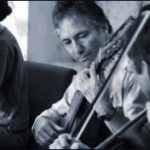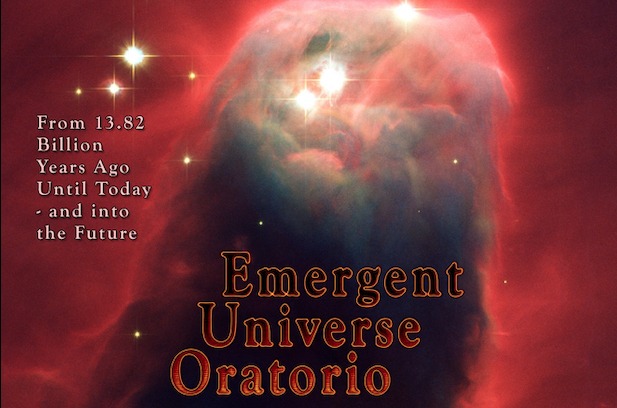As a composer of music, and a being radically in love with life – desiring more life, I will attempt to explore how ecological integrity, multi-level justice, and the yearning for peace are not only embodied in the phenomenal patterns and structures of music but empowered by its beauty, and its capacity to slip beneath the analytical mind.
Since here we are limited by language, metaphorical codes, and symbols intended to represent objects and subjects toward which they point, it is critical to share an understanding of their intent and possible interpretation. But where do we begin? Most explorations within the realms of quantum physics, biology, technology, and consciousness philosophy point toward the reality that the universe is not composed primarily of matter, but of relationships. Nothing – no thing – is isolated but exists only in respect to other things and within their collective inter-relationships. Within Earth, everything arises from the complex layers and mutually influencing systems and members of the web of life.
Ecological Integrity, Justice, and Peace
The term ecological integrity points to the radical mutuality within the exquisite complexities of the ecosphere’ the ‘house’ of life. Music’s vibrational intricacies and patterns express, and to some extent represent, the fluid and inter-responsive harmonies, melodies, and rhythms of living systems.
Justice, at any level, suggests that no part or node within the myriad layers of interdependent beings, ecosystems, and networks takes more than it needs. Good music revels in a supple balance of elements, none of them overwhelming others for prominence.
Peace, from the Earth Charter definition, ‘is the wholeness created by right relationships with oneself, other persons, other cultures, other life, Earth, and the larger whole of which all are a part.’
With these deeper understandings in mind and heart, consider the recent groundbreaking scientific discoveries cited in Peter Wohlleben’s The Hidden Life of Trees: The ‘brain-like structures at root tips’ in the vast underground mycelial networks, connecting trees with soil. The forest becoming a social network, a family, living together, communicating, supporting, sharing food, and warning of hidden threats.
Though it may seem unlikely that the origins and effects of artistic expression could be scientifically investigated – within the disciplines of evolutionary biology, neuroscience, cognition/consciousness, and complexity/systems theories – there are increasing numbers of studies with data and hypotheses suggesting connections between the dynamics of cosmic and biological evolution and ‘aesthetic’ expression and appreciation in both the human and the ‘other-than-human’ world.
Music has the power to trigger pre-civilizational evolutionary responses to the complexities of being human, and awareness of the role of beauty in shaping a worldview consonant with the intricate, multiform biosphere.
Driven by unrestrained technology – a great gift but an immense peril of modernity, with consequences hidden by the codes of language, our species’ self-imposed and functional separation from natural, life-sustaining systems, has ravaged Earth. The clearest path of liberation would have been and is, to love ourselves, each other, all life, Earth, and the totality of cosmic emergence underlying every particle and breath we take.
Robin Wall Kimmerer, the author of Braiding Sweetgrass, proposed to me these wonderful words sung by the plants. ‘We gave you everything, and still, you didn’t know we loved you?’ Hearing that voice, seeing with indigenous eyes, for we are all indigenous to Earth, is to see through the enlightened lens of ultimate self-recognition.
For me, music is an emergent phenomenon; arising from sounds and words which in turn are symbols and metaphors that arise from the natural world, experience, thought, and imagination – which in turn arise from the complex layers and mutually influencing systems and members of the web of life. In some sense, art, and music self-create or self-compose when the artist/composer allows herself to participate in a state of surrender to the emergent process. Being enveloped in music sets the analytical mind free to explore the stupendous interrelationships comprising all things and beings and to return the person imprisoned by self-isolation to her radical belonging within and as part of the living universe.

In her book Exuberance, The Passion for Life, behavioral scientist Kay Redfield Jamison explains how music acts quickly on the brain, igniting simultaneous chemical changes in individual brains within a group, and fostering cohesive responses to changing conditions. It evolved as a ‘play-space’ for the mind, where novel harmonic and rhythmic patterns evoke a mental and emotional climate in which creative leaps can be taken with no risk to survival. Oliver Sacks’ brilliant work with Parkinson’s patients showed how music overcomes symptoms ‘by transporting the brain to a higher-than-normal level of integration’ with a ‘stream of intention to which a patient can entrain his or her motions’.
Freeing Humanity from the Human Predicament
Yet the question remains: How to free humanity from The Human Predicament, and in the words of the MAHB’s hopeful mission to ‘develop and implement strategies for shifting human cultures and institutions towards practices that promote a future in which people can live peaceful and productive lives?’
Heightening our awareness of the hidden codes of language would help us on the path of liberation. Could we instead call the desecration of Earth and the greatest threats to human well-being The Biosphere Predicament, and understand that developing and implementing strategies cannot precede, nor has ever successfully preceded, a shift of vision? The great leverage points for cultural transformation are worldviews: stories that shape our concept of reality and meaning. The metaphors that have shaped civilization for centuries are ‘nature as machine’, and the story that humans are separate from nature and each other.
In our modern, industrial, and materialist society, the poetry of ideas (art and music) alone may have the power to evoke in human consciousness the psychic energy needed to ignite a new axial age, to become a mutually enhancing presence within the Earth Community (Thomas Berry).
Another way of identifying a power sufficient to trigger a rapid restructuring of both the immense physical and psychic human interrelationship is the experiential cosmology of ‘undivided wholeness’ (David Bohm) of being: a state of full bodily engagement and spiritual/emotional connection to the natural world, more frequently experienced in primordial cultures, only requiring surrendering to the gift economy of Earth, where no living being takes more than it needs without being rebalanced into the stupendous web of life.
Human culture does not and has not transformed itself in response to facts, reason, or logic. The great shifts are a response to stories. A story connects facts to meaning – representing our experience of the world and self. The greatest scientific discovery in all history is cosmogenesis – that the Universe had a beginning and is an ongoing, evolutionary totality. We are the generation to discover our place in the story of the Universe for the first time.

The Emergent Universe Oratorio in concert or in solitude can be an experience of deep ecology. An ecology of beauty in the context of our Great Origin Story, the one unifying context for all life, and what we call laws of nature. It is an ecology that includes the highest orders of complexity, the most recent thresholds, and a level of human development where we can be ravished by beauty: in the complete integration of the rational/intellectual with the intuitive and imaginative mind, and conscious perception of our absolute interdependence with every part and system of the Universe.
 Sam Guarnaccia is a composer and classical guitarist.
Sam Guarnaccia is a composer and classical guitarist.
He holds an MFA from the California Institute of the Arts and created and directed the guitar program of the University of Denver’s renowned Lamont School of Music. He instituted programs at Middlebury College and the University of Vermont as a Spanish scholar, performer, and composer. Sam writes almost exclusively music in the service of supporting an evolved consciousness of humanity’s responsibility to, and interconnectedness with, the entire Earth Community, the great scientific story of Cosmogenesis and the Epic of Evolution.
Music:
- A cycle of nine peace songs has been incorporated into a children’s peace education curriculum.
- A Celtic Mass for Peace, in collaboration with Celtic Spirituality scholar, writer, and teacher John Philip Newell, was performed in Iona, United States, and Edinburgh, Scotland. It featured in a peace celebration on the 10th anniversary of 9/11 in New York and Vermont.
- The Emergent Universe Oratorio, world premiere, Cleveland, June 2017, and Philadelphia, July 2018 at the International Big History Association World Conference.
- Threshold, for chorus and orchestra, primarily without lyrics to express the voices of all the other-than-human Earth beings and life-support systems.
All owe a debt to the extraordinary cosmic vision of Teilhard de Chardin and Thomas Berry, and their understanding of the ‘undivided wholeness’ of matter, pattern, process, and spirit.
With creative partner Paula Guarnaccia, performances and recordings are scheduled with the Albany Pro Musica (APM) Chorus and Orchestra, at the Experimental Media and Performing Arts Center (EMPAC), Troy, NY, in May 2024.
Website: www.samguarnaccia.com
The MAHB Blog is a venture of the Millennium Alliance for Humanity and the Biosphere. Questions should be directed to joan@mahbonline.org
The views and opinions expressed through the MAHB Website are those of the contributing authors and do not necessarily reflect an official position of the MAHB. The MAHB aims to share a range of perspectives and welcomes the discussions that they prompt.
